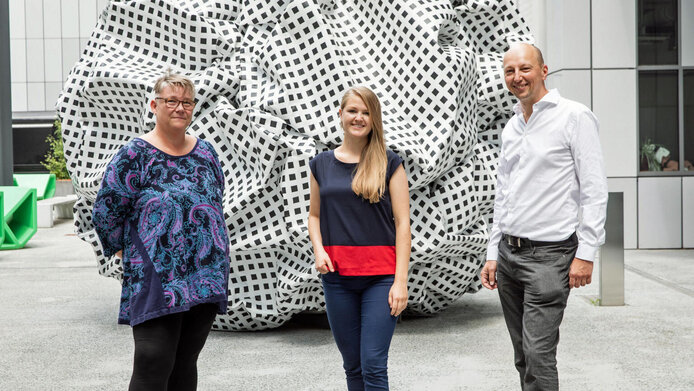Implant to improve therapy of brain tumours

“This is the first time an ion pump has been tested as a possible method to treat malignant brain tumours. We used cancer cells in the lab, and the results are extremely promising. However, it will probably take five to ten years before we see this new technology used in treatments for brain tumours”, says Daniel Simon, physicist at the Laboratory of Organic Electronics at the Department of Science and Technology at Linköping University.
Interdisciplinary research groups from Austria and Sweden are cooperating for their new approach to brain tumor therapy. In Austria at the Medical University of Graz, scientists from the fields of biophysics and neurosurgery have shared their knowledge for their experiments. They used cells from glioblastoma, which is the most common and most aggressive type of cancer that can arise in the brain. When a brain tumour is surgically removed, small parts of the tumour are often left behind, embedded between the brain cells. Even high-precision surgery cannot remove these cells without damaging the surrounding healthy brain tissue. This means that radiation treatment and chemotherapy are used to stop the recurrence of the tumour.
Ion pump directs drugs precisely into the brain
A wide variety of chemotherapeutic agents have been developed over the past decades. These chemotherapy agents are most often given either intravenously or as a tablet. But in order to reach the brain, they must first spread through the circulatory system and then pass through the blood-brain barrier. The walls of the small blood vessels in the brain are much less permeable than blood vessels in the rest of the body, and can prevent many substances in the blood entering the brain. Thus, only a few drugs that work against cancer can pass through.
The researchers at Linköping University and at the Medical University of Graz have now developed a method in which an implanted ion pump can be used to get around the blood-brain barrier and supply gemcitabine – an extremely effective chemotherapy agent that cannot normally pass the blood-brain barrier – directly into the brain with high precision. Gemcitabine is currently used to treat cancers in the pancreas, bladder and breast, where it acts by disrupting the cell division process in rapidly growing tumours. This means that gemcitabine does not affect brain cells, since these do not, in general, undergo cell division.
New method spares nerve cells
“The traditional glioblastoma treatment currently used in the clinics harms both cancer and neuronal cells to the same extent. However, with the gemcitabine ion pump, we tackle only the cancerous cells, while neurons stay healthy. In addition, our experiments on cultured glioblastoma cells show that more cancer cells are killed when we use the ion pump than when we use manual treatment”, says Linda Waldherr, postdoctoral fellow at the Medical University of Graz. She has conducted the study together with researchers at Linköping University.
When the ion pump is to transport gemcitabine from an electrolyte reservoir into cells or a tumour, a low current is used to “pump” the positively charged drug through an ion transport channel. The method is known as electrophoresis. The ion pump needs only a low current to pump the active agent, which is an advantage since it avoids the risk that brain cells are activated and transmit unintended nerve signals. The low current and voltage also mean that eventual therapeutic technology will not require large power supplies or batteries to operate.
Next steps – further testing
Rainer Schindl from the Medical University of Graz, describes other advantages: “The pressure inside the brain is extremely sensitive, and using an ion pump to transport the drug instead of a fluid-driven device means that the pressure is not affected. Also, the dosage is controlled by electrical charging, which makes the supply of the chemotherapy agent extremely precise. The next step will be to use the ion pump to evaluate different chemotherapy agents that have previously given adverse effects that are too serious or that are unable to pass the blood-brain barrier”, he says.
The Austrian Science Fund FWF co-financed the research project as part of the 1000 Ideas Programme, as did the Austrian Academy of Sciences, the Knut and Alice Wallenberg Foundation and the Swedish Foundation for Strategic Research.
Personal details
Rainer Schindl is associate Professor of Ion Channels and Optobioelectronics at the Institute of Biophysics at the Medical University of Graz. The scientist heads the 1000 Ideas Project "ELPHI: A Controllable Implant for Chemotherapy in the Brain", which was approved by the Austrian Science Fund FWF in 2020. His research focus is electrophysiology and bioelectronic medicine.
Silke Patz is senior scientist at the research unit Experimental Neurotraumatology at the University Clinic for Neurosurgery in Graz. The neurobiologist supports the project with her expertise in neuroscience and neurological disease.
Linda Waldherr is a postdoctoral researcher at the Institute of Biophysics, a division of the "Gottfried Schatz Research Centre", at the Medical University of Graz. The biochemist works on neurological diseases and drug delivery systems, among other things.
Publication
Linda Waldherr, Maria Seitanidou, Marie Jakešová et al.: Targeted chemotherapy of glioblastoma spheroids with an iontronic pump, in: Advanced Materials Technologies 2021






